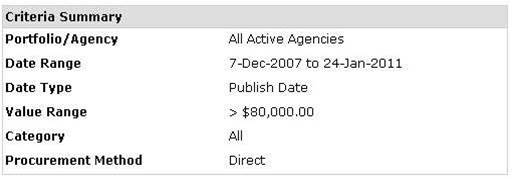OPINION: Australian taxpayers should be concerned about the ease with which our Federal Government agencies are flaunting regulations that should compel them to purchase large volumes of goods and services via an open tender process.

Commonwealth Procurement Guidelines insist on tender processes for transactions above $80,000 (or $400,000 if a Government corporation rather than an agency).
These guidelines are intended to drive value for the Australian taxpayer and to reduce the potential for corruption.
But as we have most recently seen in the case of the Department of Health – which has outsourced its IT services to the same supplier on several consecutive occasions without going to tender – the CPGs are too easily skirted using escape clauses that otherwise could mask laziness, incompetence or, at worst, corruption.
Before we dive into the Health story again – let’s take a macro view of what these loopholes could cost the taxpayer.
iTnews findings:
-
That over $3.2 billion of the $8.3 billion the Federal Government has spent on IT and telecommunications contracts during the 3+ years of the current ALP Government has been direct sourced rather than purchased via mandated tender processes.
-
The Australia’s Department of Health and Ageing has spent 76 percent of its IT contract budget on direct deals during this period, versus 52 percent at Human Services and 8 percent at the ATO.
Methodology
I'd encourage you to visit the AusTender web site. Do a search for “Contract Notice by Procurement Method Criteria”. Start with “all agencies” but restrict your search to spend on IT and telecoms – and use the current term of the ALP Government as your date range (Dec 07 til now). It is also important to choose $80,000 and up for the contract value, in accordance with the CPG guidelines.
Of the $8.35 billion spent on IT and telecoms during the term of the current ALP Government (in purchases above $80K), $3.21 billion (38 percent) of the contract value or 41.5 percent of contracts were purchased/signed via a direct sales process rather than a tender.
This means that agencies chose to purchase IT and telecommunications without going to open tender on almost as many occasions as they followed the guidelines.
These statistics track roughly in line with the 39 percent of occasions agencies went direct across all purchasing categories, which represents $42 billion of $106 billion in contract spending during the term of the current Government.
[NB - The statistics on AusTender do not go back far enough for a valid comparison of the current ALP Government versus the Howard years, as AusTender only launched in 2003 and the current requirements for publishing procurement was introduced in July 2007.]

It is here we need to stop and ask the question: What kind of savings could we expect from a tender process being applied to that $3.13 billion of IT and telecoms contracts or $42 billion across the board?
It’s a difficult formula to construct based on a lot of variables. Tender processes, to be sure, cost agencies money and need to be streamlined – but that’s why we have the $80,000 threshold. You don't want to have to write a tender document to buy some coffee at Civic Coles.
The assumption has obviously been made by the Department of Finance that above this threshold ($80K), the savings derived from the influence of market competition are likely to kick in and outweigh the cost of the tender process.
Would 20 or 25 percent savings be a good estimate? I’d like to hear your opinion on this in the comment field below. Because at that rate, one could assume savings of over half a billion dollars on IT and telecoms alone, and $8 billion across the Government. That would be a headline worth writing.
I put this issue to the Department of Finance, asking whether the rates at which procurement is going direct was higher than they would prefer.
But a spokesman for the department claimed that the CPG's simply represent a "procurement policy framework within which agencies determine their own specific procurement practices."
In other words, there is a marked difference between guidelines and law.
"It is therefore not a question of what percentage of covered procurement is direct sourced, but whether it is appropriately direct sourced," the spokesman said.
Further, the Department of Finance has never intervened in an agency's procurement process.
"Under the devolved financial framework, the Chief Executives (or the head of the Government agency) are responsible for their agency's processes and any breaches in the Financial Framework (including the requirements of the CPGs) are reported in their annual certificate of compliance," the department said.
So if not Finance, who does watch agency procurement? The Audit Office (ANAO) on occasion - but only after significant media attention. Otherwise, the heads of departments have every incentive to cover up any laziness, incompetence or corruption on the part of their procurement officers.
Now that we've looked at the macro view, let’s drill down to the most recent agency to go direct on IT – the Department of Health and Ageing (again, using the +$80,000 threshold).
DOHA has used a ‘direct’ line of purchasing for 97 out of 108 (90 percent) tenders during the term of the current ALP Government. In value terms, that is some $134 million of the $176 million (76 percent) of the contract value on IT and telecommunications that did not go to tender.
To be fair, let’s compare Health's record to other big users of IT in the Federal Government. The Australian Tax Office has gone direct on 58 out of 77 occasions over the same period (75 percent of occasions), but that represents only 8 percent ($81 million) of the $1 billion it contracted. Human Services has gone direct in 19 out of 41 occasions over the same period (46 percent of occasions), which represents over half ($72 million or 52 percent) of its $137 million contract value.
Why is DOHA spending three-quarters of its IT budget direct, compared with half at Human Services or less than 10 percent at the ATO? Read on to find out.









_(22).jpg&h=140&w=231&c=1&s=0)
_(20).jpg&h=140&w=231&c=1&s=0)



_(26).jpg&w=100&c=1&s=0)

 iTnews Executive Retreat - Security Leaders Edition
iTnews Executive Retreat - Security Leaders Edition












_(1).jpg&h=140&w=231&c=1&s=0)



